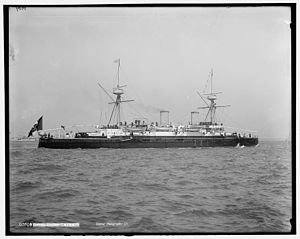 Etna in the 1890s, probably during her 1893 visit to the United States
| |
| History | |
|---|---|
| Name | Etna |
| Namesake | Mount Etna |
| Builder | Regio Cantiere di Castellammare di Stabia |
| Laid down | 19 January 1883 |
| Launched | 26 September 1885 |
| Commissioned | 3 December 1887 |
| Fate | Sold for scrap, 15 May 1921 |
| General characteristics | |
| Type | Protected cruiser |
| Displacement | 3,474 long tons (3,530 t) |
| Length | 283 ft 6 in (86.4 m) |
| Beam | 42 ft 6 in (13 m) |
| Draft | 19 ft (5.8 m) |
| Installed power |
|
| Propulsion | |
| Speed | 17 knots (31 km/h; 20 mph) |
| Range | 5,000 nautical miles (9,300 km; 5,800 mi) at 10 knots (19 km/h; 12 mph) |
| Complement | 12 officers and 296 men |
| Armament |
|
| Armor |
|
Etna was a protected cruiser of the Italian Regia Marina (Royal Navy) built in the 1880s. She was the lead ship of the Etna class, which included three sister ships. Named for Mount Etna on the island of Sicily, the ship was laid down in January 1883, was launched in September 1885, and was completed in December 1887. She was armed with a main battery of two 254 mm (10 in) and a secondary battery of six 152 mm (6 in) guns, and could steam at a speed of around 17 knots (31 km/h; 20 mph).
Etna frequently cruised abroad throughout her career, including visits to the United States for the World's Columbian Exposition and the Hudson–Fulton Celebration in 1893 and 1909, respectively. She served as a training ship for naval cadets from 1907. She saw action during the Italo-Turkish War of 1911–1912, primarily providing gunfire support to Italian troops ashore in Libya. By the outbreak of World War I in 1914, Etna had been withdrawn from service and was employed as a headquarters ship for the commander of the Italian fleet at Taranto and later for the light forces based at Brindisi. The old cruiser was finally sold for scrap in May 1921.